2013 Most Enhanced
For 17 years, Landmarks Association of St. Louis has used the Most Enhanced Awards to recognize excellence in the restoration, rehabilitation, and adaptive reuse of St. Louis' architectural heritage. Award winners are selected based on the difficulty of the project, the capacity of the project to have a transformational effect on the surrounding area, the historical or architectural significance of the building, and on the project's power to inspire. They are also selected with an eye toward a diversity of building types and development entities.
Thanks to our generous sponsors
 |  |  |
Thanks to our host, the St. Louis Public Library
 |
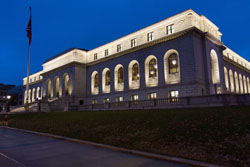 |
St. Louis Central Public Library, 1301 Olive Street
The St. Louis Public Library was designed by renowned New York architect Cass Gilbert and completed 1912 as a component of downtown's grand municipal plaza. Gilbert was selected because of his outstanding design, but also in part for his commitment to stay within a one million dollar budget, which included a $500,000 gift from Andrew Carnegie. In the end, the project went way over budget and took substantially longer than expected to complete.
In contrast, the latest renovation, despite its massive scale, came in under budget and ahead of schedule. A monograph published about the library upon completion in 1912 concluded about the building that "in addition to the education obtained from books, is the education that comes from surroundings of quietude and refined good taste. A love of beauty is an element of good citizenship and to inculcate this lesson is a proper part of the general educational function of the library."
Certainly the surroundings of refined good taste and a love of beauty were kept at the forefront of the minds of the planners, designers, and executors of the most recent and most extensive renovation of the building.
Completed this past November as the library turned 100 years old, the renovation was planned by Cannon Design and brought to life by BSI Constructors. The building was returned to its original splendor while simultaneously prepared for the needs of the 21st century with increased public space, state-of-the-art mechanical, electrical, and fire protection systems, and modern data raceways that anticipate future technology needs This building is both an architectural and civic treasure and it stands as a shining example of how an institution can accommodate the current and future needs of its mission while respecting and honoring its architectural legacy.
_______________________________________________________________________________________________________________________________________________________________
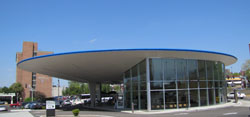 |
The Flying Saucer, 374 South Grand Boulevard
Constructed in 1967 by the Teamsters Union of St. Louis (Local 688), this unique, space-age building originally housed a service station for the adjacent Council Plaza housing development. Council Plaza was designed as a total community concept for the Teamsters, providing residential, retail, office space, a restaurant, and medical and automotive services for tenants. In an interview with Landmarks Association's Ryan Reed, the original project architect Richard Henmi, stated that he wanted the gas station to deviate from the geometric simplicity of the surrounding high and low rise buildings and serve as a centerpiece of the plaza.
The highly unique building was briefly considered as a target for demolition in 2011 earning it a place on that year's Most Endangered list. Following a surprising avalanche of support for the quirky building from area residents, developer Union Square Enterprises decided that there was opportunity in its unmistakable appearance and changed course for adaptive reuse. That decision garnered enormous local praise as well as attention at the national level from the National Trust which named the building among its Ten Remarkable Preservation Wins of 2012.
A sensitive new design by project architect Klitzing Welsch took full advantage of the building's unusual attributes, creating airy interior spaces with abundant natural light. Importantly, the rehabilitation of this building for both a Starbucks coffee shop and a Chipotle restaurant will hopefully serve as an example for other national chains operating in the St. Louis area that the occupation of existing buildings can be a viable and beneficial option when searching out locations for new franchises.
The project contractor was Paric and the developer was Union Square Enterprises consisting of Hany Abounader and Rick Yackey.
_______________________________________________________________________________________________________________________________________________________________
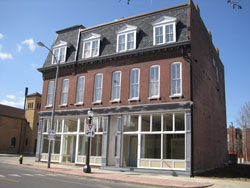 |
1435 Salisbury
This enormous corner commercial/residential building was originally constructed in 1893 as a component of a complex of buildings that included a dance hall and a three-story privy.
An important anchor at the prominent and intact corner of Salisbury and Blair in Hyde Park, the deterioration of this building (vacant for more than 30 years) had become so severe that it was included on Landmarks' Association's Most Endangered list in 2010.
The point of the Most Endangedered list is to call attention to buildings that are in dire need of assistance and whose loss would have a profound impact on the city's architectural heritage as well as on the viability of surrounding buildings. As such, it is always a great pleasure to see a building removed from the Most Endangered list because it has been rehabilitated and nominated for a Most Enhanced Award.
At the urging of Alderman Freeman Bosley Sr. this building was packaged as a component of a much larger scattered-site development known as Hyde Park South. In all, twenty six buildings are being developed representing a total project cost of eighteen million dollars being invested in a neighborhood that needs, and unquestionably deserves a bright future.
The developer was ND Consulting, The project architect was AGM Inc., Jeff Brambila was the historic preservation consultant and E.M. Harris Construction Company was the contractor.
_______________________________________________________________________________________________________________________________________________________________
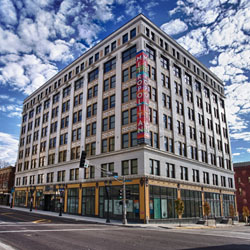 |
Metropolitan Artist Lofts, 500 North Grand Boulevard
Located at the high-profile intersection of Grand and Olive in the heart of Midtown, the former Metropolitan Building was constructed in 1907 and designed by the St. Louis firm of Mauran, Russell & Garden. Once a prominent address for doctors and other medical professionals, all of the floors aside from the street level retail spaces were vacant by the mid 1970s. As previous rehabilitation attempts failed, the building sat embarrassingly vacant and partially boarded in the midst of the otherwise flourishing Midtown arts district.
The building was acquired by Dominium Development of Minneapolis in 2011 with the intention of converting the building into artist lofts, though extreme deterioration in some areas presented unique challenges to rehabilitation. Due to corrosion of the unusual reinforced cinder concrete that had been used for floors and the roof, substantial portions of the building were collapsing. Rehabilitation required complete replacement of about 35% of the roof, 20% of the 8th floor, and about 10% of the 7th floor and all the remaining floors were reinforced with structural decking.
Rehabilitation also included restoration of marble corridor floors, historic corridor detailing and the historic lobby. The building now contains 72 lofts, two art studios, a dance studio, four soundproof practice studios, a fitness room and basement indoor parking. Not only are the people associated with this project to be commended for the enormous challenges they overcame, they are to be thanked for returning the building to service. The Metropolitan Artist Lofts Apartments represents a critical boost to the vibrancy and general appearance of the city's premier arts district, and thus improves the ability of the community at large to represent itself favorably to visitors.
Paul Hohmann with Ebersoldt + Associates was the project architect, Paric was the contractor, and Dominium Development was the developer.
_______________________________________________________________________________________________________________________________________________________________
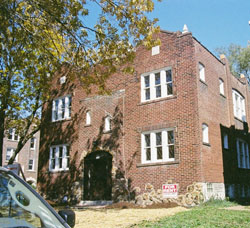 |
4557 Flad Avenue
This four-family walk up apartment building is a property type that typifies the Shaw's Garden Historic District and the Southwest Garden neighborhood in general so it is fitting that its redevelopment was made possible by the cooperative long-term planning of the Southwest Garden Neighborhood Association, the Southwest Garden Neighborhood Housing Corporation, Alderman Steve Conway, and a local businessman with a deep commitment to the community. Employing a strategy that has paid dividends for neighborhoods citywide, first a national register historic district was established at the behest of the neighborhood and alderman. This historic district was designed to attract redevelopment of problem, or deteriorating properties by making historic rehabilitation tax credits available to supplement financing. Then, the neighborhood housing corporation set out to match up potential developers with buildings in need. In this case, that brave developer was Hanoch "Chuck" Vilnai and NH Investments, and the building was among the worst in the entire neighborhood.
Mr. Vilnai renovated every aspect of the building. He installed a new roof, repointed the exterior, removed paint from the brick and stone, stabilized structural problems, removed and rebuilt the rotting porch, repaired damaged plaster walls and ceilings, repaired and refinished original floors and trim, added new mechanical systems, bathrooms, and kitchens. He also restored leaded glass windows, doors, and even the historic garage. The rehabilitation went well beyond the minimum standards to qualify for tax credits and resulted in the building becoming an example for the neighborhood and a catalyst for investment in nearby properties. This is exactly how the creation of historic districts as a tool for economic development is supposed to function at the neighborhood level, and a perfect example of how the State Historic Tax Credit in particular stabilizes buildings as well as neighborhoods.
The project architect was Fendler and Associates, the contractor was Arthur Kotets and the developer was Chuck Vilnai and NH Investments.
_______________________________________________________________________________________________________________________________________________________________
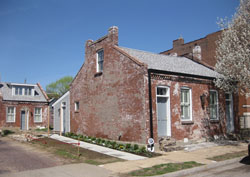 |
3339 Missouri Avenue
Clearly visible on the 1875 Compton and Dry birdseye map of St. Louis, the two buildings at 3339 Missouri were likely constructed well before the Civil War. The primary residence and alley house bear many of the hallmarks of what has been termed the Missouri German Vernacular Classical Style. This home predates much of the existing buildings in Benton Park and, when constructed, was in an area that was in a transitional zone between the city of St. Louis and the farms and dairies that supported it.
Vacant and deteriorating for well over a decade, the Benton Park Community Housing Corporation and Alderman Ken Ortmann were concerned that these early and important buildings would be lost. They worked tenaciously to secure title to the property and find a developer who was willing and able to renovate the property. They found that person in Ray Simon, an architect and long time resident of the Benton Park neighborhood. No stranger to dilapidated buildings, Ray has won multiple Most Enhanced Awards and holds a prominent place among the special breed of fearless and possibly crazy rehabbers who keep buildings like this from becoming vacant lots.
Because of the interesting and increasingly rare presence of an alley house Ray's vision for the property from the beginning was to create a space that utilized the outdoor environment to unify the two buildings. He separated public and private space and effectively created a single home that exists in two places at once. The renovation took nearly 18 months and required the help of many contractors and trades people from the immediate neighborhood. Once again, this project demonstrates how a community can work together to salvage its history and strengthen its future.
The project architect was Ray M. Simon, the contractor was Ray Simon and the owner/developer is Green Corn Dancers LLC.
_______________________________________________________________________________________________________________________________________________________________
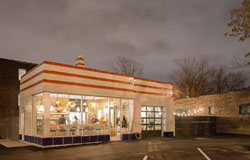 |
Elaia & Olio, 1634 Tower Grove Avenue
In the 1920s and 1930s, many corner service stations were built in residential areas to accommodate droves of new automobile owners. They were largely abandoned in the 1980s as service stations morphed into the convenience mart and moved on to major transit arteries and out of the neighborhoods. Unfortunately, they frequently left environmental problems behind in addition to small buildings that are difficult to repurpose. In addition, in their wake, they had a negative impact on surrounding homes. Who wants to live next to an abandoned gas station?
As they have done before, the Urban Improvement Company found an opportunity in buildings that on the surface were not obvious candidates for redevelopment. If only every vacant neighborhood gas station and abandoned house in St. Louis could be combined into a chic new restaurant space. Combining the internally connected service station and multi-family residence next door, Elaia & Olio is the epitome of adaptive reuse. The buildings are now a beacon of good taste and good food and demonstrate how creativity and vision can convert a neighborhood lemon into neighborhood lemonade.
The project architect was UIC, the contractor was UIC, and the owner/developer is UIC.
_______________________________________________________________________________________________________________________________________________________________
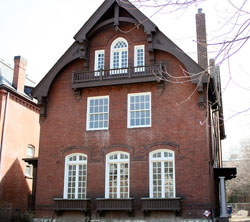 |
5074 Waterman Boulevard
Constructed in 1909 and designed by the noted St. Louis firm of Mariner & LaBeaume, the large single family home at 5074 Waterman was foreclosed upon in the same year it turned 100 years old. Fortunately, it soon caught the eye of Washington University researcher Dr. Marco Colonna, who found both the architecture and its location (a quick bike ride from his office) attractive.
Keeping things local, Dr. Colonna swiftly hired neighborhood based Core10 Architecture to handle the extensive renovation plans. The home had suffered from deferred maintenance for years and the usual range of neglect issues plagued the building when the architects began their work. The exterior of the home was at a tipping point with areas of decaying wood and masonry on the verge of failure. The original porte-cochere had rotted away, the exterior trims had deteriorated and the garage was all but collapsed.
Aside from being outdated and dark, the interior of the home was telling tales about exterior conditions with water infiltration generating mold and plaster failure. Several interior refinishings had brutalized the kitchen but thankfully nearly all of the remaining built-in cabinetry and all of the interior wood details survived untouched. Dr. Colonna invested heavily in stabilizing the structure and prioritized restoring all of the original windows and woodwork throughout.The extensive restoration work was then complimented with bright interiors and modern-yet-respectful European-inspired kitchen and bath renovations. Now, after nearly 18 months under construction and despite many delays and surprises, the house is a home once again. The project architects were Brian Wheeler and Tyler Stephens with Core10 Architecture and the contractor was Higginbotham Brothers.
_______________________________________________________________________________________________________________________________________________________________
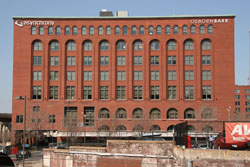 |
Cupples #9, 900-914 Spruce Street
Originally constructed in 1895 and designed by the St. Louis firm of Eames and Young, the building at 900-914 Spruce Street is a component of the City Landmark Cupples Station warehouse district. The station was originally conceived as a way of vastly improving the efficiency of freight loading and distribution services, which had previously taken place in cramped and chaotic conditions on the riverfront. The station's plan was ground-breaking and widely emulated across the country after receiving national coverage in publications including Scientific American, the Architectural Record, and Engineering News. More recently, the brick detailing and massing of the buildings served as inspiration for the new Busch Stadium, and the remaining structures supply critical density and thus vibrancy in the ballpark area, which is otherwise stifled by entrenched surface parking lots.
The station complex went downhill as centralized freight stations were replaced by flexible trucking operations and one by one the buildings went empty. Cupples 9 was abandoned by the 1970s and sat vacant and mothballed for approximately forty years before the economics of redevelopment made sense. Piggybacking on the success of the other cupples redevelopments, the Koman Group along with Space Architects and Clayco contracting not only saved the building, they created a valuable civic asset from what many considered to be just another crumbling warehouse that would be better if carted off to the landfill.
The rehabilitation took advantage of the building's open floor plans and highlighted original structural elements to create fascinating new interior spaces that masterfully blend both old and new. Today, Cupples 9 not only recalls our city's importance as a center of trade and innovation it showcases the skill and creativity of the modern St. Louis development community. It also provides a much-needed anchor of density and mixed use opportunity in the ballpark area. The project architect was Space, the developer was The Koman Group, and Clayco served as contractor.
_______________________________________________________________________________________________________________________________________________________________
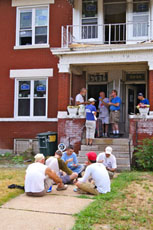 |
5936-38 Etzel Avenue
Through the Most Enhanced Awards, we not only attempt to recognize high profile projects that restore the city's architectural treasures, we attempt to recognize the diversity of the developers and the many ways in which the rehabilitation of historic buildings can serve the community. In the case of 5936-38 Etzel, the utility of rehabilitation as a means of creating affordable housing is clearly illustrated and the project deserves congratulations for both the transformation of the building and for the manner in which the work was completed.
Suffering from water damage and neglect, the decaying two-family home was far from a neighborhood asset in the Etzel-Hodiamont area of the Central West End when it was acquired by Cornerstone Corporation, a non-profit organization that has worked to provide affordable housing in the city since 1976.
In this case, Cornerstone partnered with Grace and Peace Fellowship, a church congregation, to turn the building into accommodations for graduates of a shelter for homeless women that the church runs during the winter months. Using immense amounts of volunteer muscle and skill from a diverse array of churches and other organizations, the formerly deteriorating home was converted into three sparkling living spaces including a three bedroom apartment on the upper floors and two efficiency units on the first floor. The latter are designed to provide transitional housing for the homeless.
During decades of similar redevelopment work Cornerstone has focused on providing high quality affordable housing for those in need. Not only do their projects stabilize lives and neighborhoods, they demonstrate the transformative power of service and cooperation. The project architect was the St. Louis Design Alliance, the developer was Cornerstone Corporation, the contractor was Swedlund Construction, the financing was provided by a host of private donors, churches, and foundations, and the labor was provided by good people with a commitment to serving those in need.
_______________________________________________________________________________________________________________________________________________________________
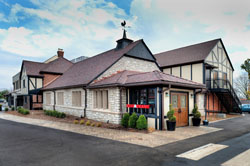 |
The Restaurant at the Cheshire Inn, 7036 Clayton Road
When CLM Rest LLC and Lodging Hospitality Management purchased the restaurant building at the Cheshire Inn, they acquired a St. Louis landmark that had defined the southwest corner of Forest Park for nearly 70 years. They also acquired a building that had been vacant since the 1990s and had experienced years of deferred maintenance with brickwork that was crumbling in places, woodwork that was rotten, overgrown vegetation growing into the walls and an interior that had been stripped of windows, paneling, molding, lighting, mantels and railings for an auction years earlier.
In 2011, LHM contracted with architect Mike Killeen to complete a restoration of the exterior based on an historic rendering. Non-historic planters, tile steps, porte cochere, a covered walk and carport were all removed and original details were carefully repaired or replaced. The greatest challenge was the installation of a new Ludowici tile roof (a replacement of the original) at great expense because of its importance to the appearance of the primary façade.
The Lawrence Group was called in to coordinate interior finishes, a project which included both restoration of remaining original finishes (including wooden beams, paneling, and terrazzo floors) and the integration of a sleek new look. The renovations took what had been a rambling space with numerous dining rooms, party rooms, bars and lounges and created a series of distinct businesses: The main Restaurant, the Market (a casual café and gourmet grocery), and Basso's basement pub. Once threatened with demolition, the iconic building is once again thriving and providing a unique anchor at this prominent intersection.
The project architects were Killeen Studios (exterior) and the Lawrence Group (interior). The contractor was Paric.
_______________________________________________________________________________________________________________________________________________________________
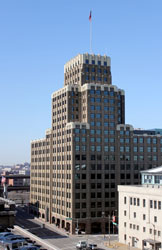 |
Robert A. Young Federal Building, 1222 Spruce Street
Completed in 1933 as a mixed use headquarters for the Terminal Railroad Association, the enormous scale and progressive art-deco design spoke of St. Louis' prominence as a center of rail traffic in the pre-world war II era. The one million square foot building was purchased by the U.S. Army in 1941 and used in large part to manufacture tank components during the war. In 1961 it was acquired by the General Services Administration to accommodate various Federal offices and in 1988 it was renamed in honor of Missouri representative Robert A. Young.
By 2009, the building was showing its age in both appearance and efficiency and thus was targeted for a major modernization effort under the American Recovery and Reinvestment Act. The thorough and sensitive modernization included bringing the nearly 80 year old building up to LEED Silver certification, complete restoration of the masonry envelope, replacement of all windows with custom energy efficient replicas of the originals, installation of renewable energy systems, a complete modernization of the 24,000 square foot cafeteria space, and renovation of 750,000 square feet of lobbies, corridors, break rooms and waiting areas.
The scale of the work that was done cannot be overstated.This project represents not just an enormous investment in one of downtown's iconic historic skyscrapers; it represents an outstanding example of how a historic building can be retrofitted to meet high standards of energy efficiency for the 21st century.
The developer was the General Service Administration, project architect was Team Four/Saur and the contractor was HOF Construction.
_______________________________________________________________________________________________________________________________________________________________
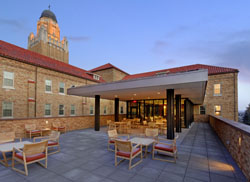 |
Kenrick-Glennon Seminary, 5200 Glennon Drive
Constructed in 1931 and designed by architect Henry Hess, Kenrick-Glennon Seminary serves as the college and graduate school of theology for the Roman Catholic Archdiocese of St. Louis. Both an architectural and institutional landmark in the St. Louis region, the archdiocese opted to implement an enormous renovation of the aging buildings in order to ensure their ability to continue to function as a top tier seminary in the 21st century.
Simply put, the facility needed an upgrade. Interiors were showing wear, systems were very dated, public spaces were dark and residence floors lacked basics such as private bathrooms and central air.
The project entailed extensive rehabilitation of the historic buildings, sensitive new additions, and general site improvements. Throughout the school, roofing was repaired, windows replaced, masonry restored, and mechanical, electrical, plumbing and fire protection systems were upgraded. In addition to renovation of existing buildings, more classrooms, library space, offices, conference rooms and lounges, a student recreation center and student residences were added. The extent of the project demonstrates and outstanding commitment on behalf of the St. Louis Archdiocese to its historic seminary, and beautifully illustrates how historic buildings and modern convenience can be combined to honor tradition while realizing progress.
The project architect was Cannon Design, the owner and developer was the Arch Diocese of St. Louis and BSI Constructors was the contractor.
